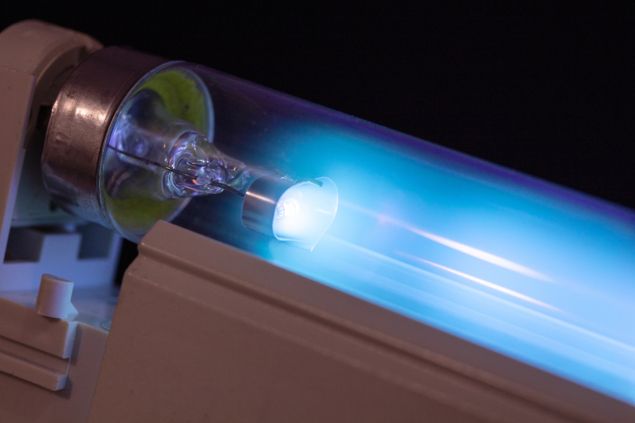
As the fight against coronavirus disease 2019 (COVID-19) continues, the consumer market for gadgets to keep you from touching doorknobs and elevator buttons, and gizmos to disinfect your phone, your packages, your groceries, glasses, shoes, and the air you breathe—just to name a few—is mind-boggling. Similarly, lots of new and old technologies are being marketed to the healthcare sector, promising cleaning and disinfection on all kinds of surfaces contaminated with SARS-CoV-2.
For instance, ultraviolet germicidal irradiation(UVGI) is a type of ultraviolet (UV) light that is composed of 3 types of light—UVA, UVB, and UVC.UVC is the most effective of all germicidal light. It was first used in the early 19th century as a method to disinfect air. It was during this time that the spread of airborne infections by droplet nuclei was discovered, and also the bactericidal effects of sunlight (UV) to prevent that spread. Despite early successes in applying UVGI, its use fell out of favor.
However, in the 1980s, an increase in infections from tuberculosis (TB) led to renewed interest in UVGI. It was found to be safe and very effective in disinfecting the air, preventing transmission of a variety of airborne infections in addition to TB.
When it comes to disinfecting the air, there are 3 primary methods of applying UVC systems against infectious agents in the air: upper-air, coil irradiation, and airstream disinfection. Upper-air systems are typically installed in room spaces, such as above patient beds, in waiting rooms, corridors and break areas, etc., where they kill airborne microorganisms that inherently circulate into the path of the UVC light.
Coil irradiation and airstream disinfection systems are installed within air handling units or duct runs within HVAC systems, downstream of cooling coils, to keep coils clean and to provide supplemental kill ratios in airstreams and on filter surfaces. Reduction of potential pathogens in the air can help prevent resettling onto surfaces, helping to contribute to a reduction in microorganism transmissions.
In healthcare, we hear a lot about UVC being used to disinfect surfaces more so than air or water. It relies on a short wavelength of light to break down microorganisms by naturally damaging their DNA and RNA, rendering them unable to replicate. Since viruses are not considered microorganisms, UVC does not actually “kill” viruses. Instead, it inactivates the virus and prevents any illnesses it might spread.
UVC has been shown to be effective in reducing pathogenic microorganisms present on frequently touched surfaces and is already being used in some hospital settings for disinfecting rooms, surfaces, and equipment. Interestingly, the US Centers for Disease Control and Prevention (CDC) lists UVC as one of the most promising methods of disinfecting air-filtering face masks, such as the N95, for reuse when there is a shortage of personal protective equipment (PPE).UVC devices are an effective means of reducing concentrations of airborne and surface microorganisms that can lead to healthcare-associated infections (HAIs).
Until very recently, UVC wavelength devices for disinfection of surfaces had not yet been proven effective against COVID-19. There were only data to support effectiveness against other coronaviruses with fairly similar RNA structures to the virus that causes COVID-19. However, on May 21, 2020, Xenex recently tested its LightStrike™ robot specifically on SARS-CoV-2 in a biomedical lab in Texas, and found that, in 2 minutes, it was able to achieve a reduction of the virus greater than 99.99% within about a 3-foot radius.
So, the effectiveness of UVC for reduction of microorganisms including bacteria, viruses, and fungi has been proven time and again. But using UVC radiation to disinfect is not simple and requires lots of protocols to use safely. The radiation must be contained, often in a device of some kind, be it a light box, robot, or tower. When UVC light is used to disinfect a room, people must be cleared from the room before the device is turned on because it can be harmful to eyes and skin. Sometimes the robots need to be repositioned to eliminate “shadowing,” which blocks the UV light from touching the surface intended for disinfection. Installing UVC lights to irradiate a room or determining the placement of mobile devices is also a complicated process and must be appropriately validated to work effectively. Some systems are very costly. Lastly, and most importantly, all surfaces need to be free of any soil or bioburden in order for the UV light to touch the surface and for disinfection to occur, therefore, it does not replace cleaning. It can be a powerful tool used as an adjunct to a thorough cleaning process.
"light" - Google News
September 14, 2020 at 10:20PM
https://ift.tt/33pikcM
UVC Light: Powerful Disinfectant, But Not Easy to Use - Infection Control Today
"light" - Google News
https://ift.tt/2Wm8QLw
https://ift.tt/2Stbv5k
Bagikan Berita Ini















0 Response to "UVC Light: Powerful Disinfectant, But Not Easy to Use - Infection Control Today"
Post a Comment